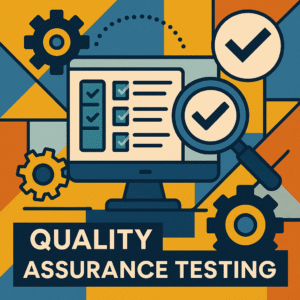What is synthetic testing?
Users demand Google-like response time that pushes companies to monitor the performance and availability of their applications continually. Accomplishing a comprehensive view of your applications requires the integration of multiple approaches and instrumentation after a release. One of the approach adopted by various sector like ecommerce, health,and banking is synthetic testing.
Synthetic testing that uses distributed test engines to dedicatedly test performance and availability of your web applications and sites remotely – even when there is no traffic. Simply deploy the scripts onto a web browser to simulate the path a real customer takes through a website. The transaction scripts or workflow test are created in advance and then uploaded to the cloud to run it after a the new code has been released into production.

Top 5 reasons to use synthetic testing
When and why should you use Synthetic Testing, here are the top five reasons to use Synthetic Testing for your web application –
Measure SLA’s
SLA could be critical when an application has a number of third parties to host. Synthetic testing helps in making informed decisions backed up by numbers be it about performance, or stability, thereby maintaining transparency. It also helps in validating performance to ensure consistent delivery of third party services before committing an SLA thereby providing best of services to your customers.
Monitoring Web application during Peak and off traffic periods
The application these days are not standalone there are number of components interface, web services, protocols, etc., as a service provider, how could you be assured all of these components work perfectly fine when integrated? That’s when Synthetic Testing comes in handy, as it helps in measuring application performance 24*7 from every node/point and alerts the IT team about the issues found, that may affect the customer. Synthetic testing helps in exploring the production environment of your app/infrastructure Interestingly, the testing could be simulated and scheduled for different regions and period like low traffic zone or during a high traffic period.
Benchmark Trends across Geographies
Once you have the data and trends you captured in one region, you could extend the same test to different areas, by monitoring the key transactions, geographies and extend validation to multiple devices and browsers.
The data collected would also help you streamlining your SLA, as you would know the[nearly] accurate time and measures are taken to rectify a particular problem.
Test business-to-business web services
Synthetic Testing helps businesses to test web services that use SOAP, REST or other web technologies. While these webservices help in building a communication with upstream and downstream, it also helps in reusing the existing web services for multiple workflows. So when one business service uses customer name to retrieve customer id, the same could also be used to get its details.
How does it complement real user monitoring to deliver better performance
While Synthetic monitoring helps in getting answers to queries like –
- Is my web application up and running?
- Is the transaction working smoothly?
- How fast is my application?
- Is there a failure or connectivity issue?
- Are my upstream and downstream system well connected?
- What is the performance of my website?
It might not be able to answer questions like –
- The experience/issues end-user is facing
- Geographical problems or browser issue not included in the synthetic test plan
- End-user actions while browsing or exploring the website
- The actual workflow took by the end user
This is where Real User Monitoring or RUM comes into the picture. RUM approach provides you an insight into how an end user interacts with your web application. Synthetic testing, on the other hand, offers the insight to “expected” user experience, so combining the power of two one could get a complete view of the user experience. Utilizing both approaches could help you in getting rid of blind spots and enhancing the user experience by providing –
- Transparency
- Reducing MTTR
- Understanding business workflow from an end-user perspective
Some tips on how to select the best synthetic testing tool
- A synthetic monitoring tool should be easy in use, so if you do not want to spend time in scripting look for record and playback tool or if you are comfortable with scripting you can explore tools that allow you to code.
- The monitoring tool should support working with complex web functionalities.
- The tool should allow users to expand their testing scripts, i.e., adding more steps or an easy way to create complex workflows.
- The tool should have reusability feature where testing scripts could be recalled whenever a new business workflow needs them like login, logout, etc.
- Ability to test all data-driven test cases
- Capable of reducing false positives as issues arise from server maintenance, glitches, sparse coding, etc
- Able to minimize overheads like retesting for any false alerts.
- The tool should perform evenly across locations thereby measuring latency and load issues
- A synthetic monitoring tool should be capable of alerting using services like SMS or email.
- With users now accessing web application via multiple devices, a tool that allows you to expand testing across devices and browsers comes in handy.
Summary
The web is filled with complications and you need to watch it round the clock, make sure the users have a glitch-free and delightful digital experience. A well-defined test strategy combined with the well-designed synthetic tool could help you in achieving expected performance and removing bottlenecks.
LIKE THIS POST SHARE IT WITH YOUR FRIENDS
RECENT POSTS
Guides

How To Select a Regression Testing Automation Tool For Web Applications
Regression testing is an essential component in a web application development cycle. However, it’s often a time-consuming and tedious task in the QA process.

Switching from Manual to Automated QA Testing
Do you or your team currently test manually and trying to break into test automation? In this article, we outline how can small QA teams make transition from manual to codeless testing to full fledged automated testing.

Why you can’t ignore test planning in agile?
An agile development process seems too dynamic to have a test plan. Most organisations with agile, specially startups, don’t take the documented approach for testing. So, are they losing on something?

Challenges of testing Single Page Applications with Selenium
Single-page web applications are popular for their ability to improve the user experience. Except, test automation for Single-page apps can be difficult and time-consuming. We’ll discuss how you can have a steady quality control without burning time and effort.

Why is Codeless Test Automation better than Conventional Test Automation?
Testing is important for quality user experience. Being an integral part of Software Development Life Cycle (SDLC), it is necessary that testing has speed, efficiency and flexibility. But in agile development methodology, testing could be mechanical, routine and time-consuming.






